By Nick Smith, 30th May 2023
Every once in awhile a product comes along that’s annoyingly good at everything.
Without wishing to seem overtly negative, today’s portable audio market has become such an ocean of “good-but-not-great” offerings that analysing the flaws in each can be an effective means of deciding your next purchase – simply choose the IEM who’s shortcomings bother you the least at your chosen price, and away you go!
Now if you’re beginning to pick up a vibe that perhaps the IEM I’m reviewing today – Penon’s latest 10th Anniversary tribrid – may in fact be perfect, rest assured they aren’t. Nothing made by human hands ever is, and at the risk of veering down the poetic side of the street I’ll muse that true beauty lies in life’s imperfections, not in a fruitless quest for faultlessness.
So Penon’s 10th Anniversary IEMs aren’t perfect, but they’re annoyingly good. What does that mean, and why should you care?
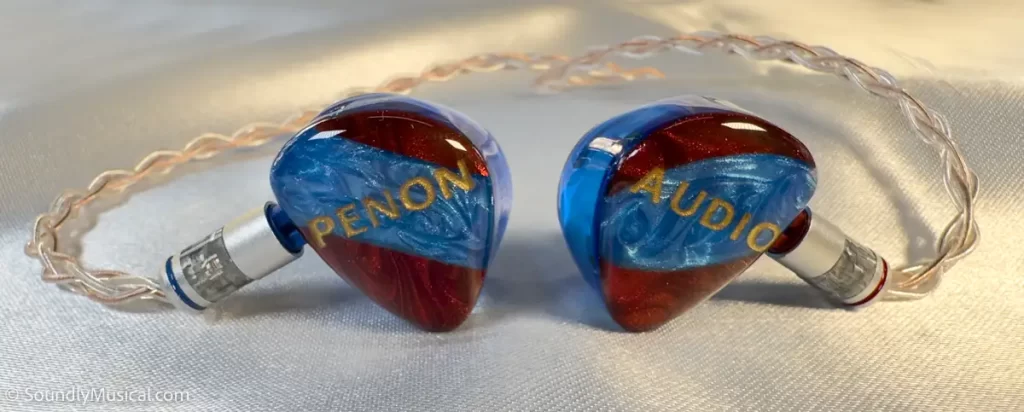
Earlier this year I was charmed by Penon’s Impact IEM, with its’ luxurious midrange and effortless resolution. Yet lacking a dynamic driver, the Impacts’ bass texture & slam occasionally left me wanting.
So when Penon announced a new product to commemorate their 10th anniversary, a hybrid IEM containing not one but two DDs my interest was piqued. After reaching out to them they agreed to provide a set of 10th Anniversary earphones at a discount on the understanding I’d pen a review.
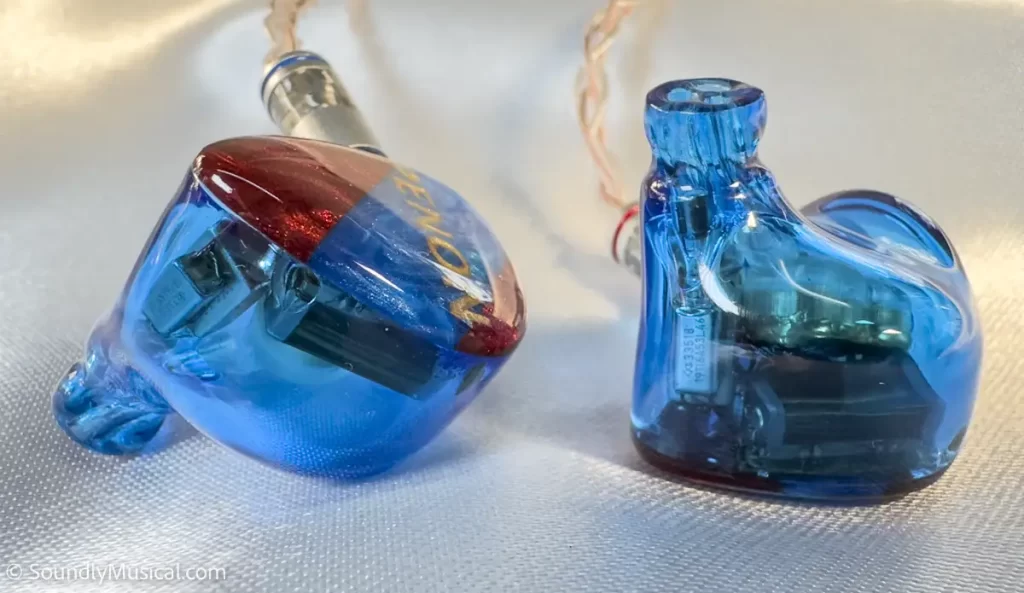
Let’s get the formalities out the way. The eponymously named 10th Anniversary IEMs (just “10th” from now on) retail for USD $499 and contain 2x 6mm DDs for the lows, 1x Sonion BA for mids, 1x Knowles BA covering highs and 2x Sonion ESTs for the ultra-highs. Made of blue medical resin with a small vent on top, there’s a total of 3 internal tubes and a 4 way crossover.
With regards to form factor, the 10th are on the larger side – slightly above average for a tribrid with a fairly low driver count, perhaps mostly due to those two DDs. I do find them shapely enough to use for hours without discomfort, but they do not disappear in quite the same way ISN’s slightly smaller EST50s do for instance. They’re comfortable, just not what I’d call petit.
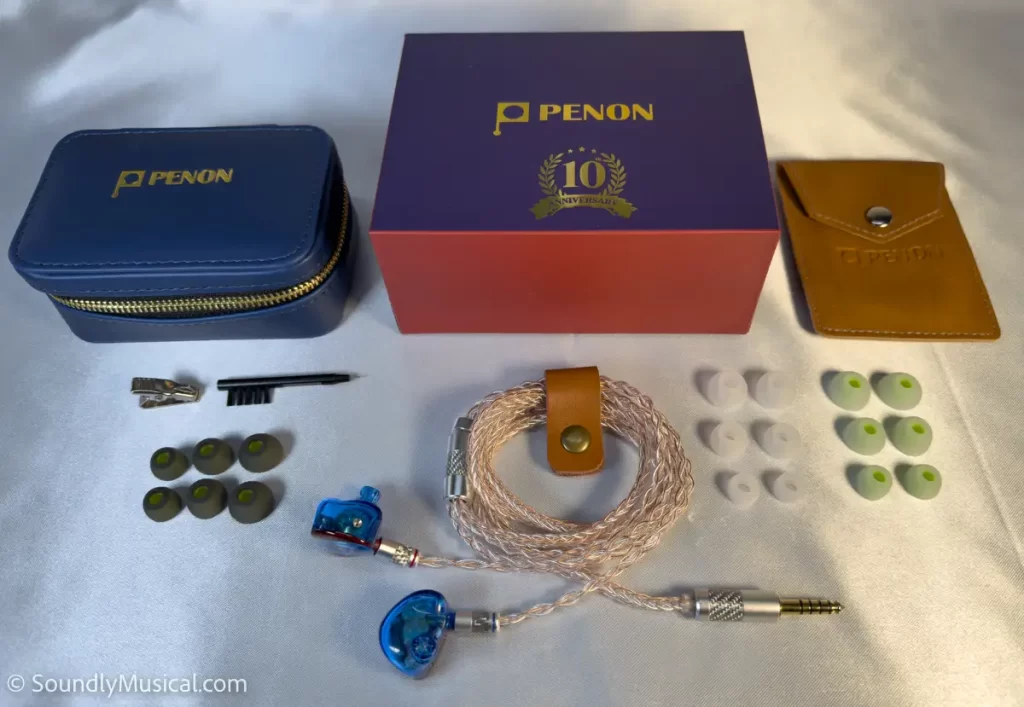
Packaging
The 10th arrived in a smallish box with a leather carry case, leather accessories case, three sets of eartips, shirt clip & IEM cleaning tool. Penon have bundled their CS819 cable with the 10th (terminated in your choice of 4.4mm, 3.5mm or 2.5mm plug) which usually sell separately for USD $49. This is a lightweight 8 wire OCC copper & SPC cable, a versatile choice I wouldn’t necessarily feel compelled to upgrade – but regardless stay tuned for cable comparisons later on!

Please note as I was one of the earlier customers to purchase the 10th, they arrived with a leather case that will not be shipped with subsequent orders – instead, those who purchase the 10th will receive both the two cases pictured above which I think you’ll agree are a substantial improvement.

Sound Impressions
Having tested the 10th primarily with a Cayin N8ii DAP (in solid state mode with P+ enabled) using local files stored on an 1TB i400 Micron micro-SD card with my preferred Spinfit W1 tips, the 10th possess either a W-shaped or mildly V-shaped sound signature depending on how you interpret those terms. Their midrange is far too rich & present to be considered V-shaped, so as a low volume listener I’d best describe them as W-shaped.
Indeed the 10th’s standout characteristic may be how superbly balanced they are across all frequencies, reminiscent of Sennheiser’s IE600. The difference here is multiple drivers delivering improved technicalities, which was always the shortcoming of the IE600’s single dynamic driver.
Utilising both DDs for a “low-frequency superposition effect”, the 10th deliver a satisfying bass experience as you might expect, tastefully north of neutral with a slight bias towards midbass, but stopping short of veering into L-shaped territory. Despite each driver being just 6mm, the net effect is they’ll satisfy all but die-hard bassheads, who’d be better served by ISN’s EST50s which I’ll compare the 10th with later.

Like most Penon IEMs, the 10th’s smooth midrange is where a lot of the magic happens. Clearly Penon have chosen to make midrange richness a brand-defining trait, so despite their slight W or V-shaped lean the 10th maintain a satisfying sense of vocal fullness without that feeling of being positioned too far back from the performers.
Treble is delivered with the sort of effortless resolution one expects from EST drivers and did not leave me needing to hunt for detail, particularly compared with IEMs in the 10th’s price range. Tiny details were rendered with sufficient delicacy without a hint of sibilance, so it’s unlikely you’ll be bothered by the 10th’s high frequencies if you happen to be treble sensitive – at least at the lower volumes I listen at. (typically 17/100 on the N8ii in High-Gain)
Technical performance is very good, above what I’d expect at this price particularly with 2 DDs present. The 10th’s stage is satisfyingly wide and surprisingly deep, though the N8ii helps in that regard. Imaging is above average without being exceptional, and dynamics similarly capable. Resolution is well above that of entry-level IEMs, and never leaves me feeling important nuances are being obscured. However those micro details are not quite as effortlessly delivered as I’ve heard from TOTL IEMs costing thousands of dollars, particularly those without DDs.
Nitpicking minor quibbles, although the 10th present a very coherent window on the music, that coherency is a hair less clean due to the presence of 2 DDs. Perhaps removing one would alleviate this minor sense of diffuseness, though doing so would undoubtedly cause other tuning issues.
The addition of more BAs & ESTs would provide that sense of effortless refinement to the midrange & treble one associates with TOTL IEMs, but for their price & driver count the 10th come surprisingly close.
Finally, though I’d argue they walk a tightrope between politeness & aggressiveness almost perfectly, you might feel they err on the side of politeness.
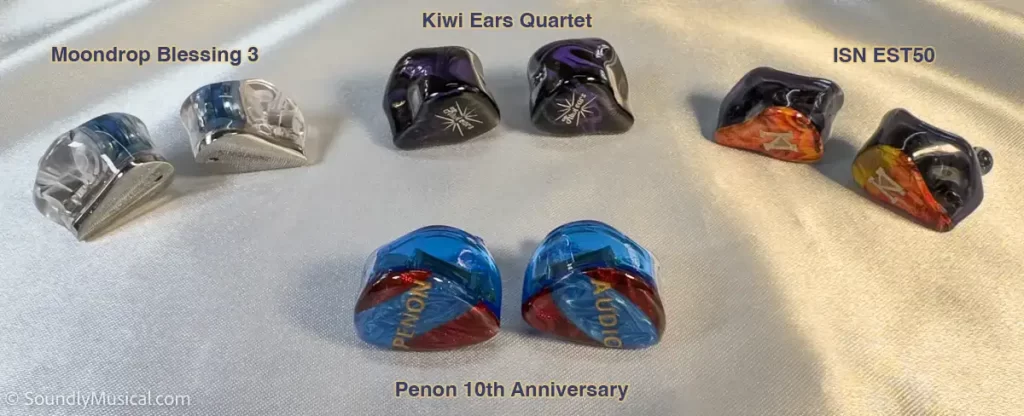
IEM Comparisons
ISN EST50 – 1xDD, 2xBA, 2xEST (USD $449)
The EST50s share many similarities with the 10th but do not overlap enough that purchasing one makes the presence of the other redundant. Nor is it easy to quantify one as “better” across the board, a more accurate descriptor would be “different”.
The ISNs are slightly smaller, lighter, and to my ears more shapely than the 10th. I find them more comfortable, but the difference in comfort wouldn’t sway my decision if forced to choose between them.
EST50s are a bombastic V-shaped hybrid with a fun, bouncy sound that is biased towards sub rather than midbass. Bass is massively above neutral, and they demonstrate considerable treble sparkle. Their coherency is slightly above that of the 10th, with marginally better dynamics, and a LOT of bass impact & slam. They’re exciting without being glarey, but do come across as more aggressive.
The 10th pull ahead by sounding significantly more refined, smooth & mature, which can leave the EST50s feeling somewhat raw, one-note or even hollow by direct comparison. The EST50s also have a flatter, slightly narrow stage and will occasionally feel like they’re pushing detail in your face in a way the 10th won’t. If you listen largely to EDM the EST50s may suit you better, but the 10th are superior all-rounders covering all genres.

Moondrop Blessing 3 – 2xDD, 4xBA (USD $319)
The B3’s are small for their driver count, slightly thinner than the EST50s, and their clear resin shells give the impression of being very well built.
They’re very fast and responsive considering the 2 DDs present, with a wider stage than the 10th and a more effortless perception of resolution.
Unfortunately that’s where the B3 good news ends, because they’re Harman Target tuned. I have nothing good to say about Harman-tuned IEMs which to my ears sound unnatural, absolutely not resembling the tonality & timbre of real instruments.
This explains why the B3’s demonstrate a frustrating sense of diffuseness, with an unacceptably hollow, anaemic thinness that clearly sacrifices frequencies necessary for accurate musical reproduction for the sake of boosting technical performance and prioritising a clinical presentation above all else.
By contrast the 10th deliver similar levels of technical ability without sounding like all life has been sucked out of the music, and are my choice over the B3’s in a heartbeat.

Kiwi Ears Quartet – 2xDD, 2xBA (USD $109)
The Quartets are budget hybrids, surprisingly large for their driver count, that never give the impression of being just $109 at first glance. They even contain a pair of tuning switches, and I found turning both to the OFF position yielded pleasing results.
Unfortunately it’s only upon listening to them do you realise spending more money might’ve been a good idea.
The Quartets are unashamedly V-shaped, reminiscent of the EST50s but with a midrange that is clearly lacking warmth & richness. That comparison suffers even further when compared to the 10th’s smooth presentation of vocals.
Biased more heavily towards the upper midrange than the 10th, the Quartets do have a decently wide stage without the EST50’s aggressiveness, but make instruments & voices feel much small than on the 10th, with appreciably lower resolution, and a flatter, less dynamic sound that struggles to leave me feeling engaged with the music. In short they fail to match the 10th in any department.

Cable Comparisons
Should you upgrade the 10th’s stock cable & what sort of benefit will you find by doing so?
The short answer is yes, the 10th are revealing enough that cable improvements will be readily discernible if your source is up to snuff, but the stock cable is adequate enough you shouldn’t feel pressured to do so.
Penon CS819 – 10th Anniversary Stock Cable (USD $49)
This 8 wire OCC copper & SPC cable is exceedingly well balanced, and has been well chosen as the stock cable.
It features a fairly deep stage, a slight bias towards upper rather than lower midrange, and is extremely light for an 8 wire cable – enough so it’s easy to forget you’re wearing it.
ISN S8 (USD $32.50)
8 wires of OCC SPC with a budget price tag, this is the EST50’s stock cable. Being so light the S8 doesn’t feel like an 8 wire cable, but does bring the V-shaped emphasis we’ve always associated with silver cables.
It delivers a cleaner presentation & blacker background than the 10th’s stock cable, with the absence of CS819’s pure copper resulting in less lower midrange emphasis. I do however prefer the greater musicality & groove of the CS819 for the 10th.
NiceHCK BlackSoul (USD $50)
A 2 wire ‘5 element alloy’ cable with distinctive looks, the BlackSoul is one of the most comfortable cables I’ve tried.
BlackSoul has an interesting way of smoothing out the treble without losing perception of detail, widening the stage in the process, though it does leave it feeling decidedly flat.
Not the best match for the 10th unless you happen find its’ treble a tad peaky.
Penon Vocal (USD $69)
This 4 wire silver-plated OCC copper & gold foil cable is one to wear if you like attracting attention. Despite looking like it was purchased in a Chinese gift shop, the Vocal is a surprisingly high quality cable that’s quickly becoming one of my favourites.
Vocal delivers -as you may have guessed- a very noticeable improvement to vocal articulation with a more forward midrange, which helps balance out the 10th’s slight V-shaped lean. Vocal also delivers improved dynamics and a blacker background, and is one of the most satisfying cable pair-ups with the 10th.
Penon Obsidian (USD $149)
This 4 wire OCC copper & gold plated copper cable is surprisingly heavy, and is one I’ve struggled to appreciate.
The Obsidian is fantastic for pushing vocals forward, improving the 10th’s midrange richness even further. What I don’t like is it projects a very narrow stage, which can almost lead to a feeling of claustrophobia.
If female vocals make up a large slice of your library the Obsidian might allow you to feel alluringly close to the singers you love, but it can struggle with other genres.
Penon Leo Plus (USD $249)
This 8 wire gold-silver-palladium alloy wire is much lighter than the Ares S 8 wire & Martini, doesn’t boost dynamics quite as much, but is better ergonomically.
Leo Plus improves the 10th’s bass quite a bit, more in the midbass rather than sub region, and also expands the soundstage width.
Imaging is improved, perhaps due to treble being emphasised quite strongly. However I notice a slight midrange cloudiness, as if tonality is sacrificed for technical performance.
Effect Audio Ares S 8 wire (USD $279)
This 8 wire OCC copper cable is a beast in every sense. Heavy, with thick earhooks, you’ll struggle to forget you’re wearing it. The Ares S 8 delivers a similarly muscular sound with a very pronounced lower-end emphasis one would expect from this much copper.
The lower midrange & midbass are boosted quite a bit, as are dynamics which is normally the case with 8 wire cables. Imaging is also improved and the stage feels slightly larger. A good choice if you crave a meatier sound for rock music.
Liquid Links Martini (USD $349)
8 wires of gold plated copper & palladium plated silver gorgeousness, I’d love to say the Martini sounds as good as it looks. Unfortunately it’s been a difficult cable to pair successfully, and that remains the case with the 10th.
Martini improves dynamics but unlike the Ares S 8 accentuates upper rather than lower midrange. It widens the stage slightly more than Ares S 8, but doesn’t feel quite as tall.
Martini’s tonality doesn’t sound quite right with the 10th and it can be slightly fatiguing, despite the sound being quite well balanced. Perhaps there’s too much upper midrange?
Liquid Links Venom (USD $1089)
Pairing the 10th with this 2 wire ‘quinary alloy’ cable worth more than double their purchase price doesn’t make much rational sense, but that’s exactly what I love about this hobby. My friend Lycos loaned me this Venom for an upcoming cable shootout so of course I couldn’t resist seeing how much the 10th benefits from it.
Venom improves the 10th’s technical performance more than any other cable tested. Venom has a somewhat v-shaped character, and sub bass in particular feels stronger.
Dynamics are boosted on par with the 8 wire cables, and stage expands similarly, but there’s enhanced resolution with a very black background no other cable could match, and it makes the 10th’s upper treble call attention to itself in a way I haven’t heard before.
No doubt you’d find better value spending more on your IEMs than such an expensive cable upgrade, but pairing Venom with the 10th brought them shockingly close to the performance of a TOTL IEM.
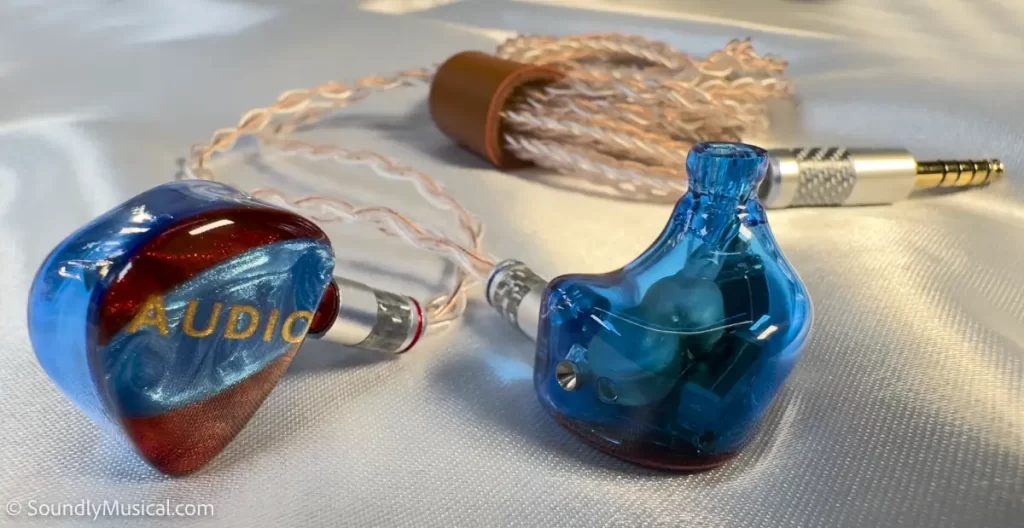
Conclusion
This has been a difficult review to write, with so little to complain about!
Penon’s 10th Anniversary earphones do just about everything well & perform splendidly with every genre of music I’ve tried. They really only suffer in comparison with IEMs with vastly higher pricetags, and even then are such great all-rounders I can imagine many of us preferring them to TOTL IEMs with more specialist appeal.
I distrust reviews that are glowingly positive and the 10th Anniversaries aren’t perfect. They could be a touch smaller, I’d love if they had more treble sparkle (without upgrading cables) and although they’ve never sounded slow, using 2 DDs means they’ll never have the blistering speed of BA or BA/EST only IEMs. Everything in life is a tradeoff.
Having said all that, I’ll say this – the 10th Anniversary are easily the safest blind buy I’ve come across since the IE600s last year. Which I suppose isn’t very long… but in this hobby even six months can feel a lifetime.
Does that make the 10th Anniversary the love of my life? Ask me when we’re back from our honeymoon!


Comments